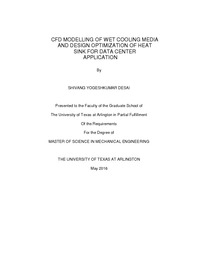
ATTENTION: The works hosted here are being migrated to a new repository that will consolidate resources, improve discoverability, and better show UTA's research impact on the global community. We will update authors as the migration progresses. Please see MavMatrix for more information.
Show simple item record
| dc.contributor.advisor | Agonafer, Dereje | |
| dc.creator | Desai, Shivang Yogeshkumar | |
| dc.date.accessioned | 2016-09-28T17:36:44Z | |
| dc.date.available | 2016-09-28T17:36:44Z | |
| dc.date.created | 2016-05 | |
| dc.date.issued | 2016-05-12 | |
| dc.date.submitted | May 2016 | |
| dc.identifier.uri | http://hdl.handle.net/10106/25881 | |
| dc.description.abstract | Air cooling is most widely used and economical method of currently available cooling technologies in which heat exchanger plays a vital role in facility designs. Evaporative cooling can be energy efficient than mechanical cooling because it uses water’s enthalpy of vaporization. Wet cooling pads can be used as the direct evaporative cooling system in which pad is made of cellulose fibers those gets wet when water injected. When hot and dry air passes through pad surfaces, water evaporates in the air which cools down air adiabatically increasing humidity. These type of cooling units can be installed in these type of climates for a use of modular data centers. Wet cooling pads are studies for greenhouse and wind tower application using system resistance model or equivalent representation of media using the box. This study focuses on compact CFD model of wet cooling pad representing an actual model of the pad surfaces. Surfaces are represented with the equivalent porous medium. These type of modelling can be used free of pad dimensions and flute angles for fixed material.
The other part of this study focuses on heat sink customization for application of oil immersion cooling in data centers. Oil immersion cooling can be promising cooling technology for high thermal loads and heat capacitance. At server level, heat sink is critical part for cooling efficiency and it is been studied widely for air cooling systems. There is a lack of literature work in studies involving heat sink for the oil immersion cooling application. This work is to provide an efficient range of operation for the heat sink with numerical modelling for first generation open compute server. Customization of the heat sink can open up to more heat load per rack. A parametric study is conducted on fixed pumping power and thermal efficiency of the heat sink for oil immersion cooling has been optimized to a cost saving value of 44%. | |
| dc.format.mimetype | application/pdf | |
| dc.language.iso | en_US | |
| dc.subject | Wet cooling media | |
| dc.subject | Oil immersion | |
| dc.subject | Heat sink | |
| dc.subject | CFD | |
| dc.subject | Evaporation | |
| dc.subject | Optimization | |
| dc.subject | Thermal resistance | |
| dc.subject | Discrete dense model | |
| dc.title | CFD MODELLING OF WET COOLING MEDIA AND DESIGN OPTIMIZATION OF HEAT SINK FOR DATA CENTER APPLICATION | |
| dc.title.alternative | CFD MODELING OF WET COOLING MEDIA AND DESIGN OPTIMIZATION OF HEAT SINK FOR DATA CENTER APPLICATION | |
| dc.type | Thesis | |
| dc.degree.department | Mechanical and Aerospace Engineering | |
| dc.degree.name | Master of Science in Mechanical Engineering | |
| dc.date.updated | 2016-09-28T17:38:51Z | |
| thesis.degree.department | Mechanical and Aerospace Engineering | |
| thesis.degree.grantor | The University of Texas at Arlington | |
| thesis.degree.level | Masters | |
| thesis.degree.name | Master of Science in Mechanical Engineering | |
| dc.type.material | text | |
Files in this item
- Name:
- DESAI-THESIS-2016.pdf
- Size:
- 1.561Mb
- Format:
- PDF
This item appears in the following Collection(s)
Show simple item record


